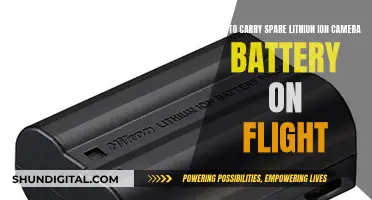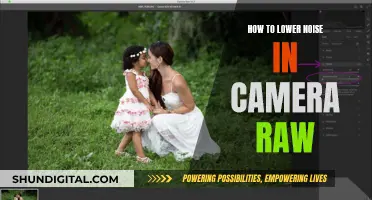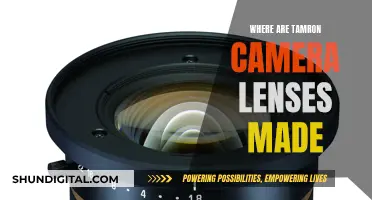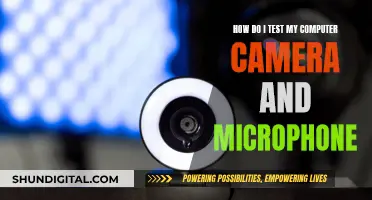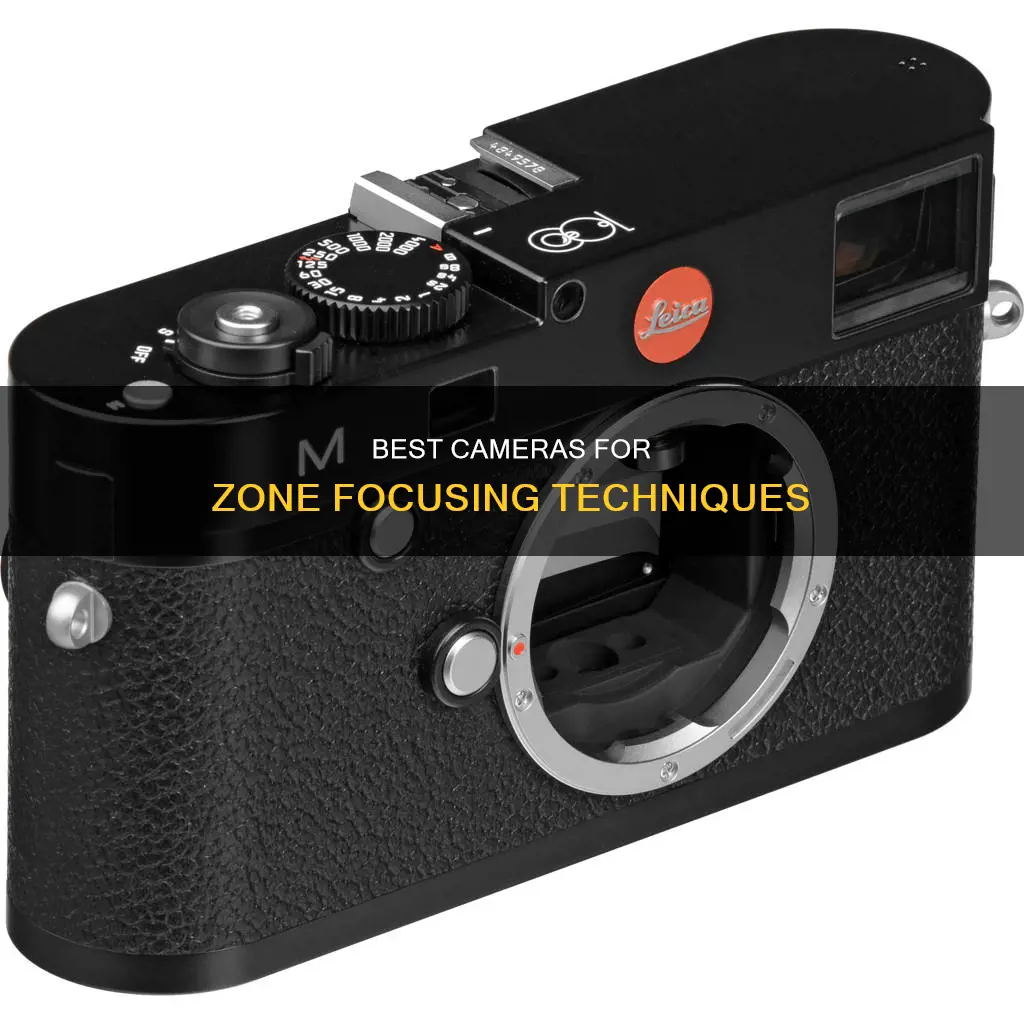
Zone focusing is a technique used by photographers to pre-set their camera's focus and aperture, allowing them to capture multiple shots without having to refocus. This is particularly useful in fast-paced or unpredictable situations such as street photography, sports, or events where the subject is constantly moving. By manually pre-focusing the camera to a specific distance, photographers can ensure that their subject remains in focus as long as it stays within the pre-defined zone. This technique is especially effective when used with wide-angle lenses of 35mm or shorter, as they offer a greater depth of field.
What You'll Learn

Zone focusing is a quick and effective method
To set up zone focusing, you need to adjust your aperture to f/8 or above, as this provides a wide enough focal plane for the technique to be effective. You then use the depth-of-field scale on your lens to determine the range of acceptable focus. For example, if you set your aperture to f/16 and adjust your focal ring to a minimum of 6ft, you will have an acceptable area of focus between 4.5 and 10 feet. This means that any subject within that range will be in focus.
Zone focusing is most effective when used with wide-angle lenses, typically up to 50mm. This is because wider lenses provide a greater depth of field, making it more likely that your subject will be sharp. Additionally, manual lenses are easier to use for zone focusing as they have distance scales, which are not always present on autofocus lenses.
Zone focusing is a valuable skill for street photographers and anyone shooting in fast-paced or unpredictable environments. It may take some practice to master, especially when it comes to judging distances, but it can greatly improve your photography by ensuring you capture those decisive moments in sharp focus.
With zone focusing, you can be confident that your camera is already focused on the desired distance, allowing you to fully immerse yourself in the scene and capture those fleeting moments without worrying about autofocus malfunctions or the need to constantly recompose your shots.
Sony HDR-CX405: Exploring the Shooting Modes
You may want to see also

It's a manual pre-focusing technique
Zone focusing is a manual pre-focusing technique that involves setting your camera to manual focus and choosing a set distance to be in focus. This technique is particularly useful in fast-paced and unpredictable environments such as street photography, where autofocus might not be quick or accurate enough to capture the perfect moment.
To use zone focusing, you need to understand the relationship between aperture, shutter speed, and film speed, often referred to as the exposure triangle. Aperture controls the depth of field, which is the area of acceptable focus in your image. By adjusting the aperture and focus distance, you can control the near and far limits of what will be in focus, creating a "zone of focus" within which your subject is likely to be. This technique requires some forethought and pre-visualisation of your shot.
When setting your zone of focus, you typically want to maximise your depth of field to increase the likelihood of your subject being sharp. Wider apertures result in a shallower depth of field, so for zone focusing, it is recommended to use an aperture of f/8 or above. The longer the lens, the narrower the depth of field at any given aperture and set distance. Therefore, zone focusing is often used with wide-angle lenses such as 35mm, rather than longer lenses.
To set your zone of focus, you can use the depth-of-field scale on your lens if it has one. Line up the aperture you have set with the distance markings to determine the range that will be in focus. Alternatively, some cameras, especially mirrorless cameras, may provide this information in the settings menu. You can also use a depth-of-field app or calculator to determine the range of a particular zone focus setting.
Zone focusing takes practice, especially when it comes to judging distances. It is a valuable skill for photographers, allowing them to capture sharp images in fast-paced situations without relying on autofocus.
Charging a VTech Camera: A Step-by-Step Guide
You may want to see also

It's best used with wide-angle lenses
Zone focusing is a technique used by photographers to capture images in fast-paced environments, such as street photography, where the subject is constantly moving and the opportunity to capture the perfect moment is fleeting. It is also used in landscape photography, where the photographer may want to capture a wide area in focus.
Zone focusing is best used with wide-angle lenses because of the depth of field they offer. The wider the lens, the more of the scene will be in focus at a given aperture. For example, if you focus a wide-angle lens, such as a 35mm, to 8 feet at an aperture of f/8, you will get an acceptable range of sharpness from approximately 5.5 feet to 15 feet. This is because a wider lens provides a wider field of view, meaning more of the scene will be in focus.
The benefit of zone focusing with a wide-angle lens is that you can be guaranteed to get sharp images without any hassle. This is because you are able to maximise your depth of field, making it more likely that your subject is sharp. The more depth of field in your image, the easier zone focusing will be.
Zone focusing with a wide-angle lens also allows for more flexibility with sharpness. The deeper your depth of field, the more flexibility you will have. This means that you can afford to be a little less precise with your focusing, which is ideal for fast-paced photography where you may not have time to adjust your settings.
It is worth noting that zone focusing with a wide-angle lens may require a higher ISO or longer shutter speed, as shooting at smaller apertures can impact image sharpness and require more light.
T3 Batteries: Compatible with T5 Cameras?
You may want to see also

It's great for street photography
Zone focusing is a great technique for street photographers. It's a quick and effective method that can help you capture the perfect moment without worrying about autofocus malfunctions or shutter lag.
Street photography is all about capturing those decisive moments, and with zone focusing, you can do just that. By manually pre-focusing your camera to a specific distance, you create a "zone" where everything within that area will be in focus. This means you don't have to worry about focusing when you're out on the streets, allowing you to be more discreet and capture candid moments without drawing attention to yourself.
To set up zone focusing, you'll need to use a high f-stop number (such as f/8 or above) with a deep depth of field. This ensures that you have a wide enough focal plane to work with. You can then pre-focus your lens to the desired distance, typically around 8 to 10 feet away for street photography. This creates a zone of acceptable sharpness, so even if your subject is not directly in the focus point, they will still be sharp and in focus.
Zone focusing is especially useful when shooting with wide-angle lenses, such as 35mm or 50mm. These lenses have a deeper depth of field, making it easier to achieve a sharp image. Additionally, zone focusing can be beneficial in low-light situations where autofocus may struggle. By increasing your ISO and using a flash or strobe, you can still achieve clear images with zone focusing.
While autofocus is a great tool, it can sometimes be unreliable, especially in fast-paced and unpredictable street photography scenarios. With zone focusing, you have more control over your camera and can capture those split-second moments without worrying about focus. It's a technique that every serious photographer should have in their arsenal, and with practice, it can become second nature.
Unlocking Camera Raw: Unfiltered Power for Your Photos
You may want to see also

It's also useful for sports, pets, kids and parties
Zone focusing is a great way to pre-set your camera's focus and aperture, then use that setting for multiple shots. It is particularly useful for sports, pets, kids, and parties, where the subjects are often in motion.
Zone focusing allows you to capture fast-paced moments with ease, ensuring that your images are sharp and focused. It is a favourite among street photographers, but it is also ideal for sports events, capturing playful pets, energetic kids, and the lively atmosphere at parties.
To use zone focusing in these scenarios, you can follow these steps:
- Determine your desired zone of focus, considering the distance between you and your subjects. For example, at a kid's birthday party, you might want to set a zone from 3 feet to 12 feet.
- Adjust your lens aperture accordingly. A wider aperture, such as f/1.8, will give you a shallower depth of field, while a narrower aperture like f/16 will provide a greater depth of field, keeping more of your scene in focus.
- Use a wider lens, such as 35mm or shorter. Wider lenses offer a greater depth of field, making it easier to capture moving subjects.
- Practice judging distances. Before you start shooting, try to estimate the distance to objects around you. This skill will help you set your focus accurately when using zone focusing.
- Consider the lighting conditions. Zone focusing works best in well-lit environments. If you're in a dark setting, you may need to increase your ISO or use additional lighting, such as a flash, to ensure proper exposure.
By following these steps and practising your technique, you'll be able to capture amazing shots of sports events, playful pets, active kids, and vibrant parties, all while keeping your images sharply focused.
Exporting from AE: Camera Raw Controls Explained
You may want to see also
Frequently asked questions
Zone focusing is a technique where you manually pre-focus your camera and lens, and adjust your aperture, for a specific distance where everything will be in focus and have a deep depth of field.
Zone focusing is great for street photography, sports photography, and capturing pets, kids, and parties. It's also useful for any subjects in motion or in situations where you need to take photos quickly.
Zone focusing works best with lenses 35mm or shorter due to their greater depth of field. You should also use a high f-stop number with a deep depth of field (e.g. f/16 or f/11) and pre-focus your camera to a certain distance.
You can use the depth-of-field scale on your lens. Line up the aperture you have set the lens to with the distance markings to determine what will be in focus. Alternatively, you can use a depth of field app or calculator to figure out the range of a particular zone focus setting.


